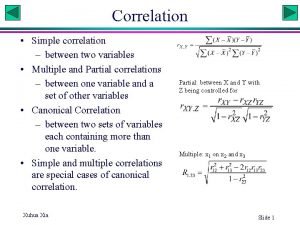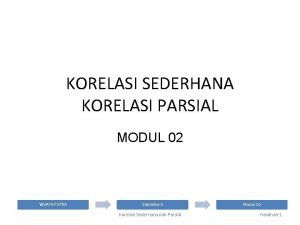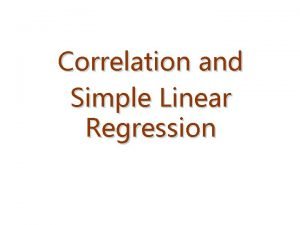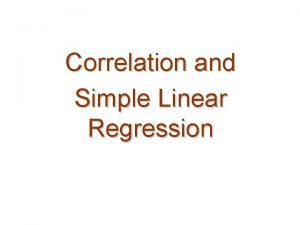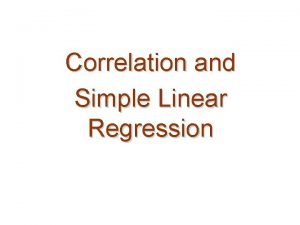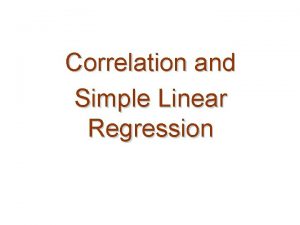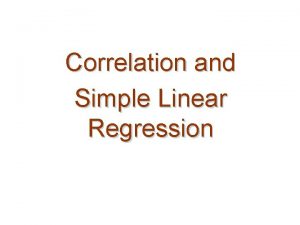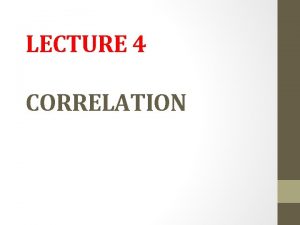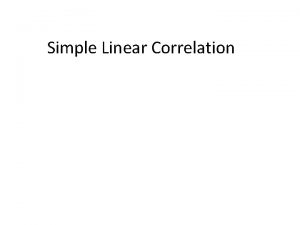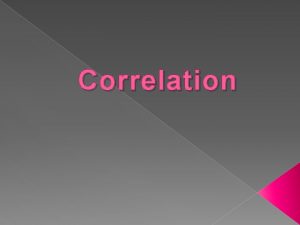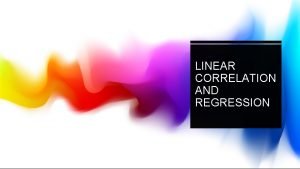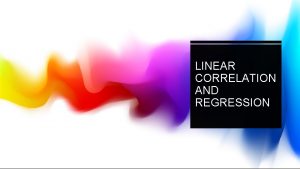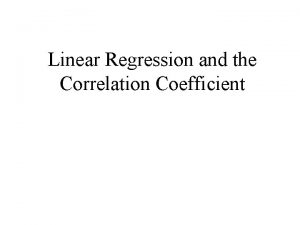SIMPLE LINEAR CORRELATION SIMPLE LINEAR CORRELATION DEFINITION OF












- Slides: 12

SIMPLE LINEAR CORRELATION

SIMPLE LINEAR CORRELATION DEFINITION OF CORRELATION • “If two or more quantities vary in sympathy so that movements in one tend to be accompanied by corresponding movements in other(s) then they are said to be correlated. ” Or • “Correlation is an analysis of co-variation between two or more variables. ”

TYPES OF CORRELATION • The following are different types correlation: • Positive and Negative Correlation • Simple, Partial and Multiple Correlation • Linear and Non-linear Correlation of

Positive and Negative Correlation • The correlation between two variables is said to be positive or direct if an increase (or a decrease) in one variable corresponds to an increase (or a decrease) in the other. • The correlation between two variables is said to be negative or inverse if an increase (or a decrease) corresponds to a decrease (or an increase) in the other.

Simple, Partial and Multiple Correlation • Simple Correlation: It involves the study of only two variables. For example, when we study the correlation between the price and demand of a product, it is a problem of simple correlation. • Partial Correlation: It involves the study of three or more variables, but considers only two variables to be influencing each other. For example, if we consider three variables, namely yield of wheat, amount of rainfall and amount of fertilizers and limit our correlation analysis to yield and rainfall, with the effect of fertilizers removed, it becomes a problem relating to partial correlation only. • Multiple Correlation: It involves the study of three or more variables simultaneously. For example, if we study the relationship between the yield of wheat per acre and both amount of rainfall and the amount of fertilizers used, it becomes a problem relating to multiple correlation.

Linear and Non-linear Correlation • Linear Correlation: The correlation between two variables is said to be linear if the amount of change in one variable tends to bear a constant ratio to the amount of change in other variable. • Non-linear (or Curvilinear): The correlation between two variables is said to be non-linear or curvilinear if the amount of change in one variable does not bear a constant ratio to the amount of change in other variable.

METHODS OF STUDYING CORRELATION • Scatter Diagram Method • Karl Pearson’s Coefficient of Correlation, and • Rank Correlation Method

Scatter Diagram Method • A scatter diagram of the data helps in having a visual idea about the nature of association between two variables. If the points cluster along a straight line, the association between two variables is linear. Further, if the points cluster along a curve, the corresponding association is non-linear or curvilinear. Finally, if the points neither cluster along a straight line nor along a curve, there is absence of any association between the variables.



Covariance • The covariance between X and Y, is denoted by Cov (X, Y)

Thankyou Lecture sourced from • Book “Business Mathematics and Statistics” by R. S. Bhardwaj • Book “Business Mathematics and Statistics” by Dr. J. K. Thukral
 Positive correlation versus negative correlation
Positive correlation versus negative correlation Positive negative no correlation
Positive negative no correlation Simple multiple linear regression
Simple multiple linear regression What is simple correlation
What is simple correlation Rumus korelasi sederhana
Rumus korelasi sederhana Causal-comparative research definition
Causal-comparative research definition Past simple for future
Past simple for future Simple present and simple future
Simple present and simple future Present simple present continuous past simple future simple
Present simple present continuous past simple future simple Present simple present continuous past simple
Present simple present continuous past simple Future simple in the past
Future simple in the past Present past future simple present continuous exercises
Present past future simple present continuous exercises Simple present tense simple past tense simple future tense
Simple present tense simple past tense simple future tense



